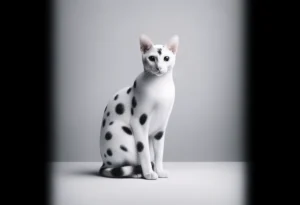White cats are often beloved for their striking appearance, but did you know that many of them are also deaf? It’s a surprising and interesting phenomenon that raises questions about genetics and biology.
Genetics of White Cats
White cats are often associated with deafness due to a genetic link between their coat color and hearing ability. The same gene that gives these felines their stunning white fur also plays a role in their hearing impairment. This gene is responsible for producing pigment-producing cells called melanocytes. In white cats, a mutation in this gene can lead to an absence of these cells not only in their fur but also in their inner ears, affecting their hearing.
One interesting fact to note is that blue-eyed white cats are more likely to be deaf than those with orange or yellow eyes. This is because the gene responsible for blue eyes, known as the W gene, is linked to the gene that causes deafness. Therefore, white cats with blue eyes are at a higher risk of experiencing hearing loss.
Types of Deafness in White Cats
Deafness in white cats can be classified into two main types: congenital deafness and acquired deafness. Congenital deafness is present at birth and is usually associated with genetic factors. On the other hand, acquired deafness can occur later in a cat’s life due to infections, trauma, or age-related changes.
A unique aspect of congenital deafness in white cats is that it is often unilateral, meaning it affects only one ear. This can sometimes be challenging to diagnose since the cat may still exhibit normal behavior despite their hearing impairment. It’s essential for white cat owners to be mindful of any signs of deafness, such as lack of response to sounds or startling easily, to provide the necessary support and care for their furry friends.
Prevalence of Deafness in White Cats
Deafness is more common in white cats due to a genetic anomaly that affects the pigmentation of their fur and inner ear. Up to 85% of white cats with two blue eyes are born deaf in at least one ear. This condition is known as congenital deafness and is most prevalent in white cats with blue eyes. Breeds such as Turkish Van, Maine Coon, and Scottish Fold are more likely to produce white cats with this genetic predisposition.
Apart from genetics, the lack of pigmentation in the inner ear can cause nerve cells responsible for hearing to deteriorate. This results in sensorineural deafness, where sound cannot be transmitted effectively from the ear to the brain. Regular vet check-ups are essential for white cats to monitor their hearing and overall health. If you suspect your white cat is deaf, consult your veterinarian for a proper diagnosis and advice on how best to care for them.
Unique Insight: White cats with odd eyes (one blue eye and one eye of a different color) are less likely to be deaf in comparison to those with two blue eyes. This is because the gene responsible for coat color and blue eyes is more strongly tied to deafness than eyes of different colors.
Blue Eyes and Deafness
The correlation between blue eyes and deafness in white cats is a result of the same gene responsible for their pigmentation. Cats with blue eyes have a higher likelihood of being deaf due to issues with pigmentation in the inner ear. This lack of pigmentation can lead to nerve degeneration and subsequent deafness in white cats.
If you have a white cat with blue eyes, it’s crucial to be aware of the increased risk of deafness and take steps to ensure their safety. Keeping them indoors and providing a safe environment is essential to prevent accidents due to their lack of hearing. Regular visits to the vet can help monitor any signs of hearing loss and address any concerns promptly.
Key tip: If you have a white cat with blue eyes, consider using visual cues instead of vocal commands for training and communication to ensure they can understand you effectively.
Caring for a Deaf White Cat
Deaf white cats require some special care to ensure they live happy and healthy lives. Contrary to popular belief, not all white cats are born deaf, but a genetic correlation between white coat color and deafness exists. The lack of pigment in the inner ear can cause degeneration of the cochlear structures, leading to deafness in some white cats.
When caring for a deaf white cat, it’s essential to provide a safe environment. Ensure they are indoors only or supervised closely when outside to prevent accidents. Use visual cues like hand signals or stomping on the floor to communicate with your feline friend. Additionally, consider getting a collar with a bell so they can feel vibrations and be aware of your presence.
Regular veterinary check-ups are crucial to monitor your white cat’s overall health. Consult your vet on any specific needs or accommodations your deaf cat may require, such as potential behavior issues or dietary adjustments.
Remember, with patience, understanding, and a little extra care, deaf white cats can lead fulfilling lives just like their hearing counterparts.
Interesting Facts About White Cats
White cats are not only beautiful but also fascinating creatures with unique characteristics. Did you know that while most white cats with blue eyes are deaf, those with one blue eye may also have a hearing impairment in the ear on the same side as the blue eye? This unusual feature makes white cats even more intriguing.
Here are some more interesting facts about white cats: – White cats are more prone to sunburns, so it’s essential to limit their exposure to direct sunlight. – Some cultures consider white cats symbols of good luck and prosperity. – White cats with odd eyes (each eye a different color) are often referred to as “kaleidoscope cats” and are considered especially unique.
White cats are truly a special breed with a charm all their own. Embrace their uniqueness and provide them with the care and love they deserve.
Remember, each white cat is an individual with its own personality and needs, so get to know your furry friend to understand what makes them happy and healthy.
Myths and Misconceptions
White cats being deaf is often associated with myths and misconceptions that need to be debunked. Contrary to popular belief, not all white cats are deaf. The link between white fur and deafness is primarily due to a genetic mutation that affects pigmentation in the inner ear. Specifically, white cats with blue eyes are more likely to be deaf than those with other eye colors. It’s important to understand that deafness in white cats is not a universal trait, but rather a higher likelihood based on specific genetic factors.
Unique Challenges and Joys
Having a white cat that is deaf comes with its own set of challenges and joys. While communication with a deaf cat may require alternative methods such as hand signals or visual cues, the bond that forms between owner and pet can be incredibly special. The unique challenges of caring for a deaf cat can ultimately lead to a deeper connection and a heightened sense of empathy. Additionally, the joy of seeing your deaf white cat thrive and overcome obstacles can be incredibly rewarding. Remember, patience and understanding are key in fostering a strong relationship with a deaf white cat.
- Training: Deaf white cats can be successfully trained using visual cues and positive reinforcement techniques. Consistent training and patience are essential in helping your cat adapt to their deafness.
- Environmental Modifications: Making simple modifications to your home, such as using vibrations to get your cat’s attention or providing safe spaces for exploration, can greatly benefit a deaf cat’s quality of life.
- Regular Vet Check-Ups: Regular check-ups with a veterinarian experienced in caring for deaf cats are crucial to monitoring your pet’s overall health and addressing any specific needs they may have.
- Bonding Time: Spending quality time with your deaf white cat, engaging in interactive play, and creating a safe and stimulating environment are key components of building a strong and positive relationship.
- Community Support: Connecting with other owners of deaf white cats through online forums or support groups can provide valuable insights, tips, and emotional support on this unique journey.
Remember, each deaf white cat is an individual with their own personality and needs. By understanding and embracing the challenges and joys of having a white cat that is deaf, you can cultivate a fulfilling and enriching companionship that transcends communication barriers.
The Future for Deaf White Cats
Advancements in veterinary science bring hope for deaf white cats. Researchers are constantly exploring new treatments and technologies to improve the quality of life for these furry friends. From cochlear implants to gene therapy, there are exciting possibilities on the horizon.
One promising area of research is stem cell therapy, which holds potential for regenerating damaged inner ear cells in deaf cats. This innovative approach could revolutionize how we address hearing loss in our beloved pets. Additionally, ongoing studies are investigating the genetic factors that contribute to deafness in white cats, opening the door to targeted interventions and preventive measures.
As we look to the future, it’s crucial to support these advancements in veterinary science. By staying informed and advocating for research in this field, we can help ensure a brighter future for deaf white cats. Together, we can make a difference in the lives of these special animals.
Tips for Supporting Deaf White Cats:
- Provide a safe and quiet environment to minimize stress on their sensitive hearing.
- Use visual cues and hand signals for communication instead of relying solely on verbal commands.
- Regular veterinary check-ups can help monitor their overall health and address any specific needs related to their deafness.
- Consider consulting with a specialist in feline deafness for personalized care and guidance.
- Show patience and understanding in your interactions with deaf white cats, as they rely on your support and compassion.
Alex, a passionate animal lover, has experience in training and understanding animal behavior. As a proud pet parent to two dogs and three cats, he founded AnimalReport.net to share insights from animal experts and expand his knowledge of the animal kingdom.




